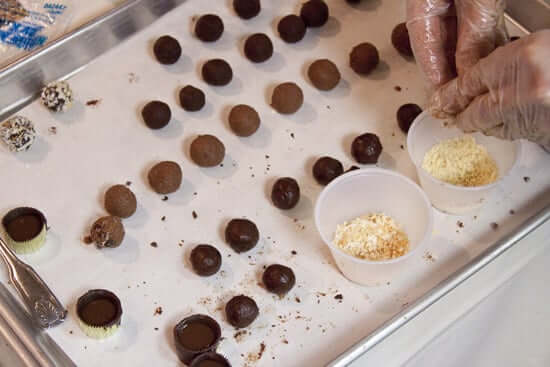
Whew, things have been busy lately, but I finally have a little extra time to blog about two events that I’ve been meaning to share for awhile now. The first is a fabulous virtual bake sale, being hosted by my blogging buddies Jen and Cara, that will benefit Susan G. Komen for the Cure. Being a cancer researcher myself, I understand the importance of raising money for studies, and I encourage you all to head over to the site and make a bid on one of the many mouth watering goodies from Wednesday, May 4 to Friday, May 6 next week. I’m donating a batch of my M&M Cashew Pretzel Bars and plan to bid on the Crusty White Bread with Rosemary and Sea Salt – yum!

I also wanted to tell you about a fantastic chocolate workshop I attended last month with Shannon. It’s run by Boston Chocolate Tours and focuses on tempering chocolate and making truffles. I received two complimentary tickets to the class, but I received no compensation for this post and all opinions are mine, of course!

Our instructor Dorian, who is a retired pastry chef, started by telling us about the history of chocolate while he whisked up some hot chocolate for us to enjoy (which was phenomenal by the way, I’ve made the real deal several times at home now using his suggested ratio of 2-3 ounces of chocolate for every 5 ounces of milk).

He then ran us through the science behind why it’s important to temper chocolate. Basically, chocolate is made up of several types of crystals, but you have to coax them to all be beta crystals in order for the chocolate to be organized perfectly so it snaps nicely when you break it and is nice and shiny. Tempering is essential when you’re dipping truffles in chocolate! He explained how tempering is all about time, motion, and temperature, and we learned how to use a double boiler to temper chocolate properly. You basically heat the chocolate to 110˚F, then cool it by adding additional chocolate (called the seed) to 85˚F, then slightly warm it back to 90˚F, all while stirring well the entire time. Then it’s ready to go!

We got a ton of helpful tips. He suggested getting a milk frothing thermometer because it’s in the range that is needed for tempering. He also suggested using a heating pad to keep the chocolate warm while you’re working with it after it’s been tempered. Also, I didn’t realize this before, but it’s really important to only use high quality chocolate with no added ingredients (which many brands of chocolate chips have) – only cocoa butter, cocoa liquor/paste (sometimes referred to as unsweetened chocolate), sugar, vanilla, and soy lecithin (an emulsifier) should be on the label.

Next, we learned how to make ganache, which was the center of all our truffles. We had four types of ganache to use – dark, milk, raspberry, and caramel – the caramel was my favorite. Then we rolled our ganache into truffles and decorated them. I dipped some in tempered chocolate and coated others with some of the toppings they had, including ground almonds, cocoa nibs, and toasted coconut. I ended up with a huge box of truffles to take home and Apolinaras and I savored each and every one – they were fabulous! If you’re ever visiting Boston, I highly recommend checking out this class or one of their tours. Tickets are $75 and you can register here. Thank you Boston Chocolate Tours for this fun foodie adventure!

